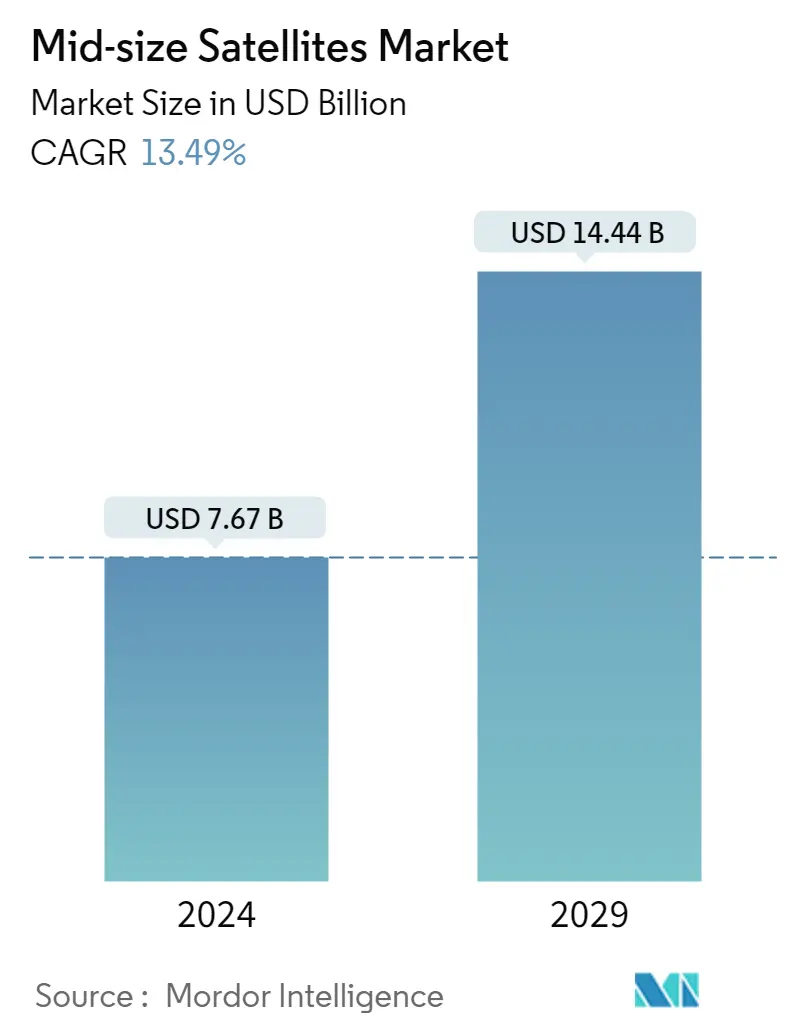Market Size of mid-size satellites Industry

|
|
Study Period | 2017 - 2029 |
|
|
Market Size (2024) | USD 7.67 Billion |
|
|
Market Size (2029) | USD 14.44 Billion |
|
|
Largest Share by Orbit Class | LEO |
|
|
CAGR (2024 - 2029) | 13.49 % |
|
|
Largest Share by Region | Asia-Pacific |
Major Players |
||

|
||
|
*Disclaimer: Major Players sorted in no particular order |
Mid-size Satellites Market Analysis
The Mid-size Satellites Market size is estimated at USD 7.67 billion in 2024, and is expected to reach USD 14.44 billion by 2029, growing at a CAGR of 13.49% during the forecast period (2024-2029).
7.67 Billion
Market Size in 2024 (USD)
14.44 Billion
Market Size in 2029 (USD)
-22.64 %
CAGR (2017-2023)
13.49 %
CAGR (2024-2029)
Largest Market by Propulsion Tech
73.93 %
value share, Liquid Fuel, 2022
Due to its high efficiency, controllability, reliability, and long lifespan, liquid fuel-based propulsion technology is an ideal choice for space missions. It can be used in various orbit classes for satellites.
Largest Market by Application
54.49 %
value share, Earth Observation, 2022
Earth observation satellites are used for weather forecasting, forestry mapping, and pollution monitoring. The growing adoption of VAS by private companies and organizations is likely to fuel the growth of satellite-based Earth observation.
Largest Market by Satellite Subsystem
25 %
value share, Propulsion Hardware and Propellant, 2022
The demand for these propulsion systems is driven by the launch of mass satellite constellations into space. They are used for transferring the spacecraft to the orbit.
Leading Market Player
70.75 %
market share, China Aerospace Science and Technology Corporation (CASC), 2022

China Aerospace Science and Technology Corporation is the largest player in the global mid-size satellites market. CASC offers a diverse range of launch vehicles and adopts a competitive pricing strategy to attract customers across the world.
Second Leading Market Player
6.18 %
market share, Airbus SE, 2022

Airbus is the second leading player in the global mid-size satellites market with a robust distribution channel.
Increased development of small and medium satellites is expected to drive the adoption rate of LEO satellites from 2023 to 2029
- Medium satellites or mid-size satellites weighing 500 to 1,000 kg are being launched in the LEO orbit and are expected to continue the same throughout the forecast period. LEO orbit occupied the majority of the market share of 85.3% in 2017.
- Depending on the type of application or mission, a particular satellite or an entire satellite constellation is launched in various types of orbit. Different satellites manufactured and launched across all the regions have different applications. For instance, during 2017-2022, out of the 167 large satellites launched, 114, 43, 8, and 2 were placed in LEO, MEO, GEO, and elliptical orbits, respectively.
- With respect to the market shares, LEO orbit is expected to lead the market, and it is expected to occupy a share of 84% in 2023 and 83.1% in 2029. The high market share is because of its close proximity and several other advantages triggered by technological developments. GEO orbit is expected to register a share of 9% in 2023, and it is anticipated to occupy a share of 7% in 2029.
- The multi-function capabilities of these satellites, such as the increasing uses of satellites in areas like electronic intelligence, Earth science/meteorology, laser imaging, optical imaging, and meteorology, are expected to drive the demand for the development of these satellites during the forecast period.
Increased development of small and medium satellites is expected to drive the adoption rate of LEO satellites from 2023 to 2029
- The global mid-size satellite market is expected to grow at a steady pace due to the increasing demand for satellite-based services across various industries, such as telecommunications, government, and defense. North America is the largest market for mid-size satellites, with the United States being the major contributor. The US government is the major customer of mid-size satellites for military and intelligence purposes. The European mid-size satellite market is driven by the increasing demand for satellite-based navigation services, particularly in the automotive and transportation industries. The Asia-Pacific mid-size satellite market is being driven by a growing demand for satellite-based telecommunications and remote sensing services. The mid-size satellite market in the Rest of the World is also experiencing growth due to the increasing demand for satellite-based communications in rural and remote areas.
- The global mid-size satellite market is witnessing several trends, including the development of miniaturized satellite components and more efficient propulsion systems. The miniaturization of satellite components is reducing the cost of manufacturing and launching mid-size satellites. This is expected to increase the demand for mid-size satellites, particularly in developing countries. The market is also driven by the increasing investments by governments and private companies in the space industry. Overall, the market is expected to continue its steady growth in the coming years, driven by increased demand for satellite-based services across various industries and regions. The market is also expected to be fueled by advancements in satellite technology, including the development of miniaturized satellite components.
Mid-size Satellites Industry Segmentation
Communication, Earth Observation, Navigation, Space Observation, Others are covered as segments by Application. GEO, LEO, MEO are covered as segments by Orbit Class. Commercial, Military & Government are covered as segments by End User. Electric, Gas based, Liquid Fuel are covered as segments by Propulsion Tech. Asia-Pacific, Europe, North America are covered as segments by Region.
- Medium satellites or mid-size satellites weighing 500 to 1,000 kg are being launched in the LEO orbit and are expected to continue the same throughout the forecast period. LEO orbit occupied the majority of the market share of 85.3% in 2017.
- Depending on the type of application or mission, a particular satellite or an entire satellite constellation is launched in various types of orbit. Different satellites manufactured and launched across all the regions have different applications. For instance, during 2017-2022, out of the 167 large satellites launched, 114, 43, 8, and 2 were placed in LEO, MEO, GEO, and elliptical orbits, respectively.
- With respect to the market shares, LEO orbit is expected to lead the market, and it is expected to occupy a share of 84% in 2023 and 83.1% in 2029. The high market share is because of its close proximity and several other advantages triggered by technological developments. GEO orbit is expected to register a share of 9% in 2023, and it is anticipated to occupy a share of 7% in 2029.
- The multi-function capabilities of these satellites, such as the increasing uses of satellites in areas like electronic intelligence, Earth science/meteorology, laser imaging, optical imaging, and meteorology, are expected to drive the demand for the development of these satellites during the forecast period.
| Application | |
| Communication | |
| Earth Observation | |
| Navigation | |
| Space Observation | |
| Others |
| Orbit Class | |
| GEO | |
| LEO | |
| MEO |
| End User | |
| Commercial | |
| Military & Government | |
| Other |
| Propulsion Tech | |
| Electric | |
| Gas based | |
| Liquid Fuel |
| Region | |
| Asia-Pacific | |
| Europe | |
| North America | |
| Rest of World |
Mid-size Satellites Market Size Summary
The mid-size satellites market is poised for significant growth, driven by the increasing demand for satellite-based services across various sectors such as telecommunications, government, and defense. These satellites, typically weighing between 500 to 1,000 kg, are predominantly launched into Low Earth Orbit (LEO), which has historically held a substantial market share due to its proximity and technological advantages. The market is characterized by the multi-functional capabilities of mid-size satellites, which are increasingly utilized in areas like electronic intelligence, Earth science, and meteorology. The development of miniaturized components and efficient propulsion systems is further reducing manufacturing and launch costs, making these satellites more accessible, particularly in developing regions. This technological advancement, coupled with rising investments from both governments and private entities, is expected to sustain the market's steady expansion.
Regionally, North America leads the market, with the United States being a major contributor, particularly for military and intelligence applications. Europe is witnessing growth driven by the demand for satellite-based navigation services, while the Asia-Pacific region is expanding due to increased needs for telecommunications and remote sensing services. The Rest of the World is also experiencing growth, fueled by the demand for satellite communications in rural areas. The market is fairly consolidated, with major players like Airbus SE, China Aerospace Science and Technology Corporation, Northrop Grumman Corporation, OHB SE, and Thales dominating the landscape. Recent developments, such as the European Space Agency's proposed budget increase and significant satellite launches by countries like India and China, underscore the global commitment to advancing satellite technology and infrastructure.
Mid-size Satellites Market Size - Table of Contents
-
1. MARKET SEGMENTATION (includes market size in Value in USD, Forecasts up to 2029 and analysis of growth prospects)
-
1.1 Application
-
1.1.1 Communication
-
1.1.2 Earth Observation
-
1.1.3 Navigation
-
1.1.4 Space Observation
-
1.1.5 Others
-
-
1.2 Orbit Class
-
1.2.1 GEO
-
1.2.2 LEO
-
1.2.3 MEO
-
-
1.3 End User
-
1.3.1 Commercial
-
1.3.2 Military & Government
-
1.3.3 Other
-
-
1.4 Propulsion Tech
-
1.4.1 Electric
-
1.4.2 Gas based
-
1.4.3 Liquid Fuel
-
-
1.5 Region
-
1.5.1 Asia-Pacific
-
1.5.2 Europe
-
1.5.3 North America
-
1.5.4 Rest of World
-
-
Mid-size Satellites Market Size FAQs
How big is the Mid-size Satellites Market?
The Mid-size Satellites Market size is expected to reach USD 7.67 billion in 2024 and grow at a CAGR of 13.49% to reach USD 14.44 billion by 2029.
What is the current Mid-size Satellites Market size?
In 2024, the Mid-size Satellites Market size is expected to reach USD 7.67 billion.

